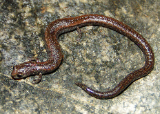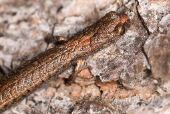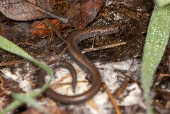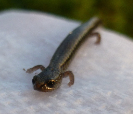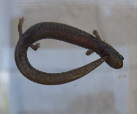Gregarious Slender Salamander (Batrachoseps gregarius)
Description: Adults are 1 1/5 to 1 4/5 inches long from snout to vent. A small slim salamander with 17 to 19 costal grooves. Short limbs, a long slender body with a narrow head and a long tail, and conspicuous costal and caudal grooves give this species the worm-like appearance typical of most Slender Salamanders. There are four toes on the front and hind feet, which is typical of all Slender Salamanders. (Other California salamanders have five toes on the hind feet.) The ground color is dark blackish-brown with a lighter brownish dorsal stripe with tan highlights and dark flecks. Many small white spots mark the ground color. The venter is lighter, dark to pale gray.
Habitat: Mostly found in oak woodlands in the foothills, but they are also found in high-elevation coniferous forests, and grasslands on the floor of the Central Valley, including very hot and dry habitats at the southern end of its range.
Range: Endemic to California. Occurs along the west slope of the central and southern Sierra Nevada Mountains from the southern boundary of Yosemite National Park almost to the Kern River. They follow some drainages down from the Sierra Nevada foothills onto the floor of the Central Valley, including around Merced, Chowchilla, Berenda Slough in Madera County, Porterville, and the San Joaquin River north of Fresno.
Found in these States:
CA
Diet: Most likely eats a variety of small invertebrates. Feeding behavior is not known, but other Batrachoseps species are sit-and-wait predators that use a projectile tongue to catch prey.
Reproduction: Reproduction is terrestrial. Breeding and egg laying occurs with the beginning of fall rains, which varies from year to year and with elevation (typically November to early January at lower elevations, and late March to late April at higher elevation locations.) Females lay eggs in communal nests in the spring (fall in southern populations) in moist places under rocks, logs, bark, or leaf litter. Females then abandon the nests. Nest sites have been found with from 10 to 300 eggs. Females at the northen end of the range lay more eggs - an average of 15.3 eggs, than those at the southern end of the range who average 7.3 eggs. Young hatch fully formed. Young develop completely in the egg and hatch fully formed.
Status: Listed as Least Concern in view of its wide distribution, presumed large population, and remaining suitable habitat across its range.
»» Kingdom: Animalia - Animals
»» Phylum: Chordata - Chordates
»» Subphylum: Vertebrata - Vertebrates
»» Class: Amphibia - (Amphibians)
»» Order: Caudata - Salamanders
»» Family: Plethodontidae - Lungless Salamanders
»» Genus: Batrachoseps
»» Species: Batrachoseps gregarius - Gregarious Slender Salamander
This article uses material from the Wikipedia article "Gregarious Slender Salamander", which is released under the Creative Commons Attribution-Share-Alike License 3.0. Content may have been omitted from the original, but no content has been changed or extended.
|





